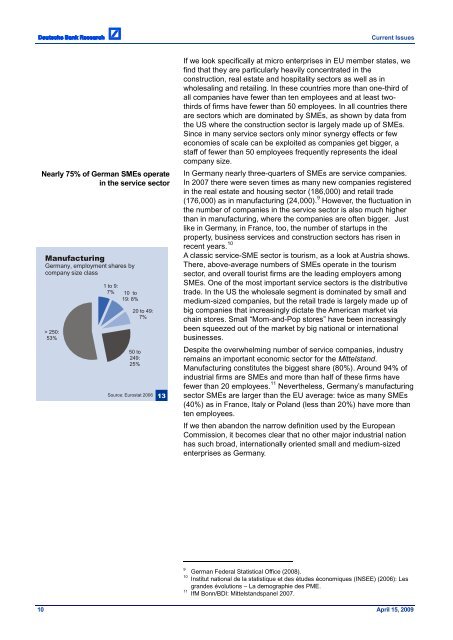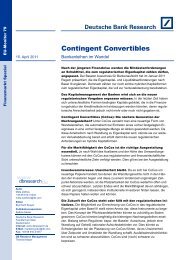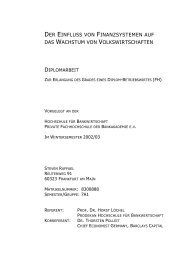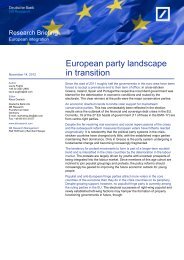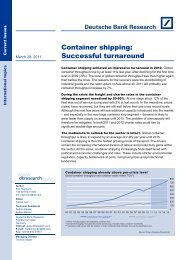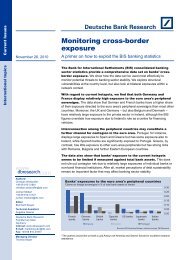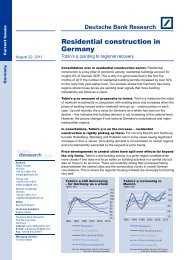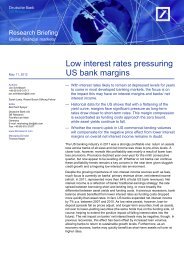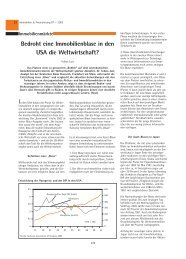Dynamic diversity opens up opportunities - Deutsche Bank Research
Dynamic diversity opens up opportunities - Deutsche Bank Research
Dynamic diversity opens up opportunities - Deutsche Bank Research
Create successful ePaper yourself
Turn your PDF publications into a flip-book with our unique Google optimized e-Paper software.
Nearly 75% of German SMEs operate<br />
in the service sector<br />
Manufacturing<br />
Germany, employment shares by<br />
company size class<br />
> 250:<br />
53%<br />
1 to 9:<br />
7% 10 to<br />
19: 8%<br />
20 to 49:<br />
7%<br />
50 to<br />
249:<br />
25%<br />
Source: Eurostat 2006 13<br />
Current Issues<br />
If we look specifically at micro enterprises in EU member states, we<br />
find that they are particularly heavily concentrated in the<br />
construction, real estate and hospitality sectors as well as in<br />
wholesaling and retailing. In these countries more than one-third of<br />
all companies have fewer than ten employees and at least twothirds<br />
of firms have fewer than 50 employees. In all countries there<br />
are sectors which are dominated by SMEs, as shown by data from<br />
the US where the construction sector is largely made <strong>up</strong> of SMEs.<br />
Since in many service sectors only minor synergy effects or few<br />
economies of scale can be exploited as companies get bigger, a<br />
staff of fewer than 50 employees frequently represents the ideal<br />
company size.<br />
In Germany nearly three-quarters of SMEs are service companies.<br />
In 2007 there were seven times as many new companies registered<br />
in the real estate and housing sector (186,000) and retail trade<br />
(176,000) as in manufacturing (24,000). 9 However, the fluctuation in<br />
the number of companies in the service sector is also much higher<br />
than in manufacturing, where the companies are often bigger. Just<br />
like in Germany, in France, too, the number of start<strong>up</strong>s in the<br />
property, business services and construction sectors has risen in<br />
recent years. 10<br />
A classic service-SME sector is tourism, as a look at Austria shows.<br />
There, above-average numbers of SMEs operate in the tourism<br />
sector, and overall tourist firms are the leading employers among<br />
SMEs. One of the most important service sectors is the distributive<br />
trade. In the US the wholesale segment is dominated by small and<br />
medium-sized companies, but the retail trade is largely made <strong>up</strong> of<br />
big companies that increasingly dictate the American market via<br />
chain stores. Small ―Mom-and-Pop stores‖ have been increasingly<br />
been squeezed out of the market by big national or international<br />
businesses.<br />
Despite the overwhelming number of service companies, industry<br />
remains an important economic sector for the Mittelstand.<br />
Manufacturing constitutes the biggest share (80%). Around 94% of<br />
industrial firms are SMEs and more than half of these firms have<br />
fewer than 20 employees. 11 Nevertheless, Germany’s manufacturing<br />
sector SMEs are larger than the EU average: twice as many SMEs<br />
(40%) as in France, Italy or Poland (less than 20%) have more than<br />
ten employees.<br />
If we then abandon the narrow definition used by the European<br />
Commission, it becomes clear that no other major industrial nation<br />
has such broad, internationally oriented small and medium-sized<br />
enterprises as Germany.<br />
9 German Federal Statistical Office (2008).<br />
10 Institut national de la statistique et des études économiques (INSEE) (2006): Les<br />
grandes évolutions – La demographie des PME.<br />
11 IfM Bonn/BDI: Mittelstandspanel 2007.<br />
10 April 15, 2009


